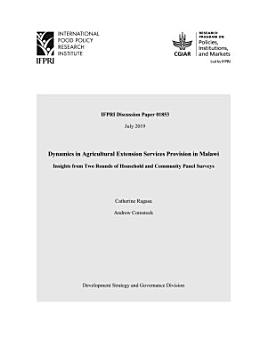Dynamics in agricultural extension services provision in Malawi: Insights from two rounds of household and community panel surveys
Ragasa, Catherine · Comstock, Andrew
elo 2019 · IFPRI Discussion Paper Kirja 1 · Intl Food Policy Res Inst
E-kirja
50
sivuja
family_home
Kelvollinen
info
reportArvioita ja arvosteluja ei ole vahvistettu Lue lisää
Tietoa tästä e-kirjasta
The Government of Malawi is in the process of developing its National Agricultural Extension Strategy. Two rounds of national household and community surveys (2016, 2018), coupled with in-depth interviews and focus group discussions, were implemented to provide research evidence supporting the Strategy’s development. This paper summarizes emerging trends from these surveys and monitors progress in extension services provision, players and actors in extension services provision, and evidence on the coverage and effectiveness of extension approaches. Positive trends include (1) improvements in the percentage of men and women farmers accessing extension services; (2) consistently high ratings in the perceived quality of extension services; (3) more diversity in extension messages, including more information regarding market access and nutrition; (4) greater use of cost-effective tools, such as radio programming and community or group meetings, as sources of agricultural information; and (5) greater crop diversification, although diversification outside of agriculture remains low. Four areas remain weak and need further improvements. First, information sharing among farmers, friends, and neighbors is frequent, and the coverage of those officially trained “lead farmers” (those trained specifically to promote technologies to other farmers) remains low, with only 7 percent of households reporting getting relevant advice from them. Second, while there are more “model villages” and “village agricultural committees” present, we see decreasing participation and ratings for these. Third, we observe greater awareness of promoted technologies, including conservation agriculture, pit planting, and sustainable land practices, but adoption remains very low. Fourth, we observe greater crop diversification, but farm productivity and commercialization remain low. Although we have investigated many dimensions and factors in this paper, there remain challenges and puzzles that could be further addressed in future research. These include constraints on the adoption of minimal expensive inputs and low-cost management practices, constraints on the role of intensive training and labor, and understanding the drivers and factors affecting commercialization and diversification.
Arvioi tämä e-kirja
Kerro meille mielipiteesi.
Tietoa lukemisesta
Älypuhelimet ja tabletit
Asenna Google Play Kirjat ‑sovellus Androidille tai iPadille/iPhonelle. Se synkronoituu automaattisesti tilisi kanssa, jolloin voit lukea online- tai offline-tilassa missä tahansa oletkin.
Kannettavat ja pöytätietokoneet
Voit kuunnella Google Playsta ostettuja äänikirjoja tietokoneesi selaimella.
Lukulaitteet ja muut laitteet
Jos haluat lukea kirjoja sähköisellä lukulaitteella, esim. Kobo-lukulaitteella, sinun täytyy ladata tiedosto ja siirtää se laitteellesi. Siirrä tiedostoja tuettuihin lukulaitteisiin seuraamalla ohjekeskuksen ohjeita.











